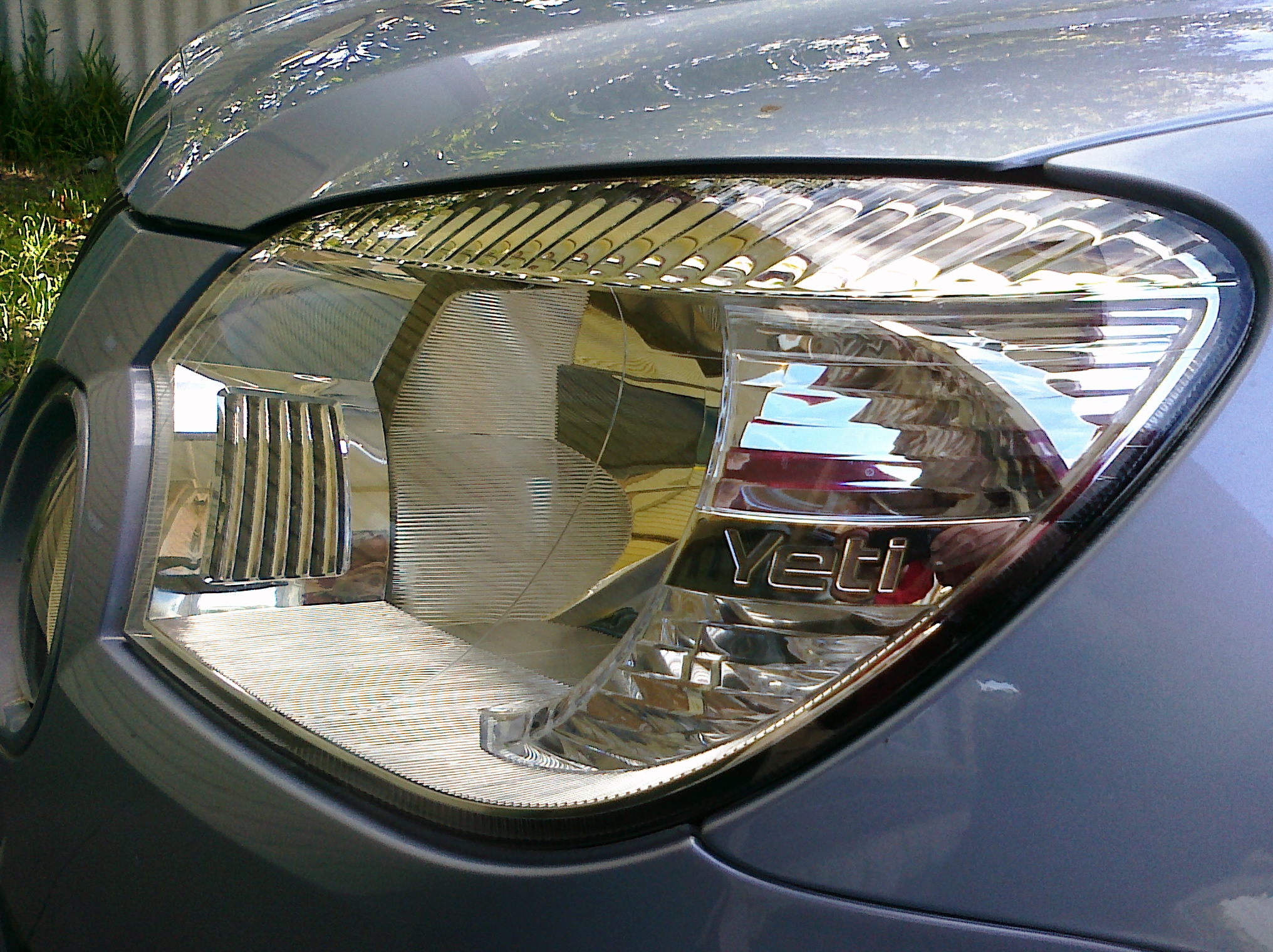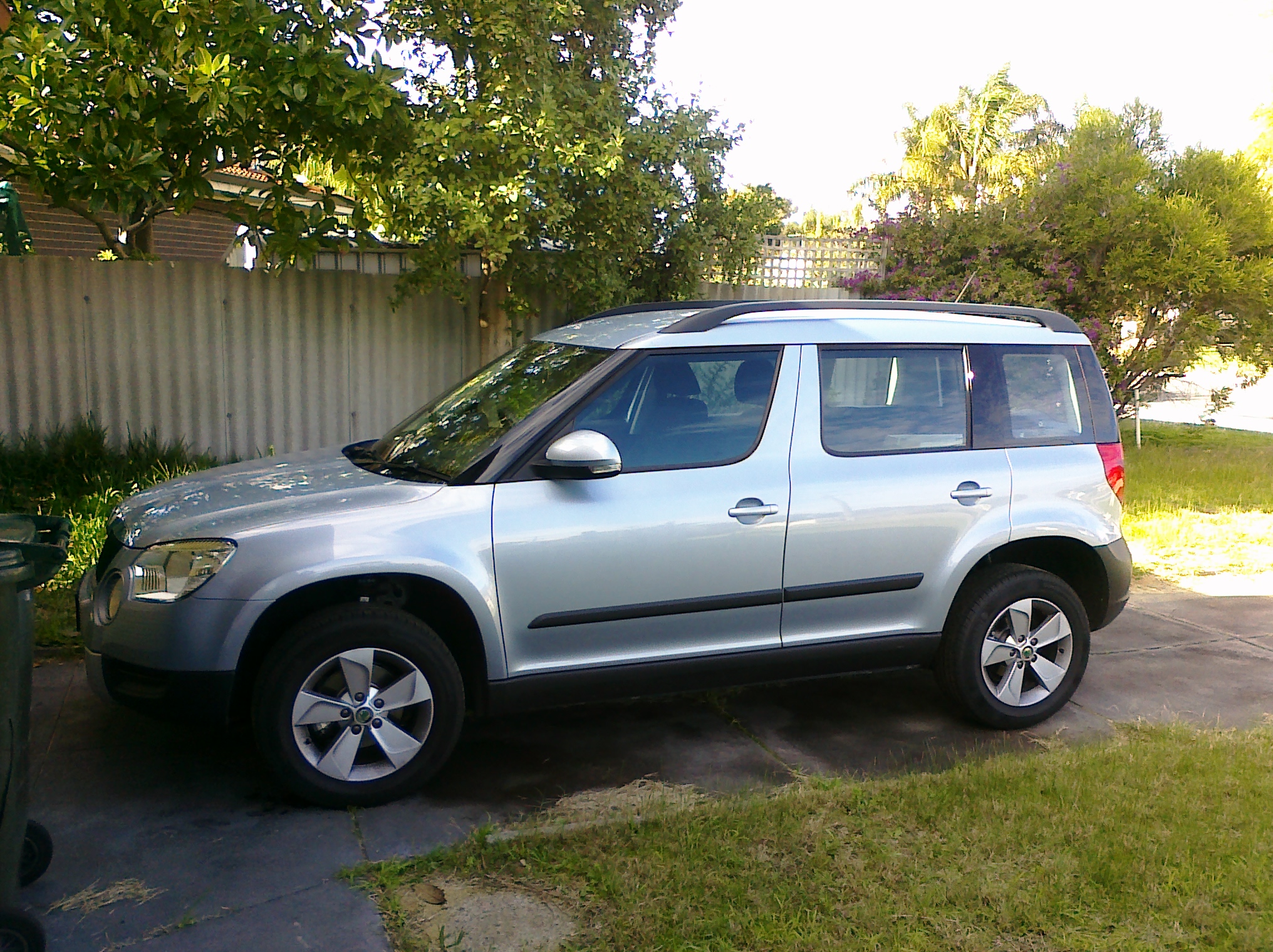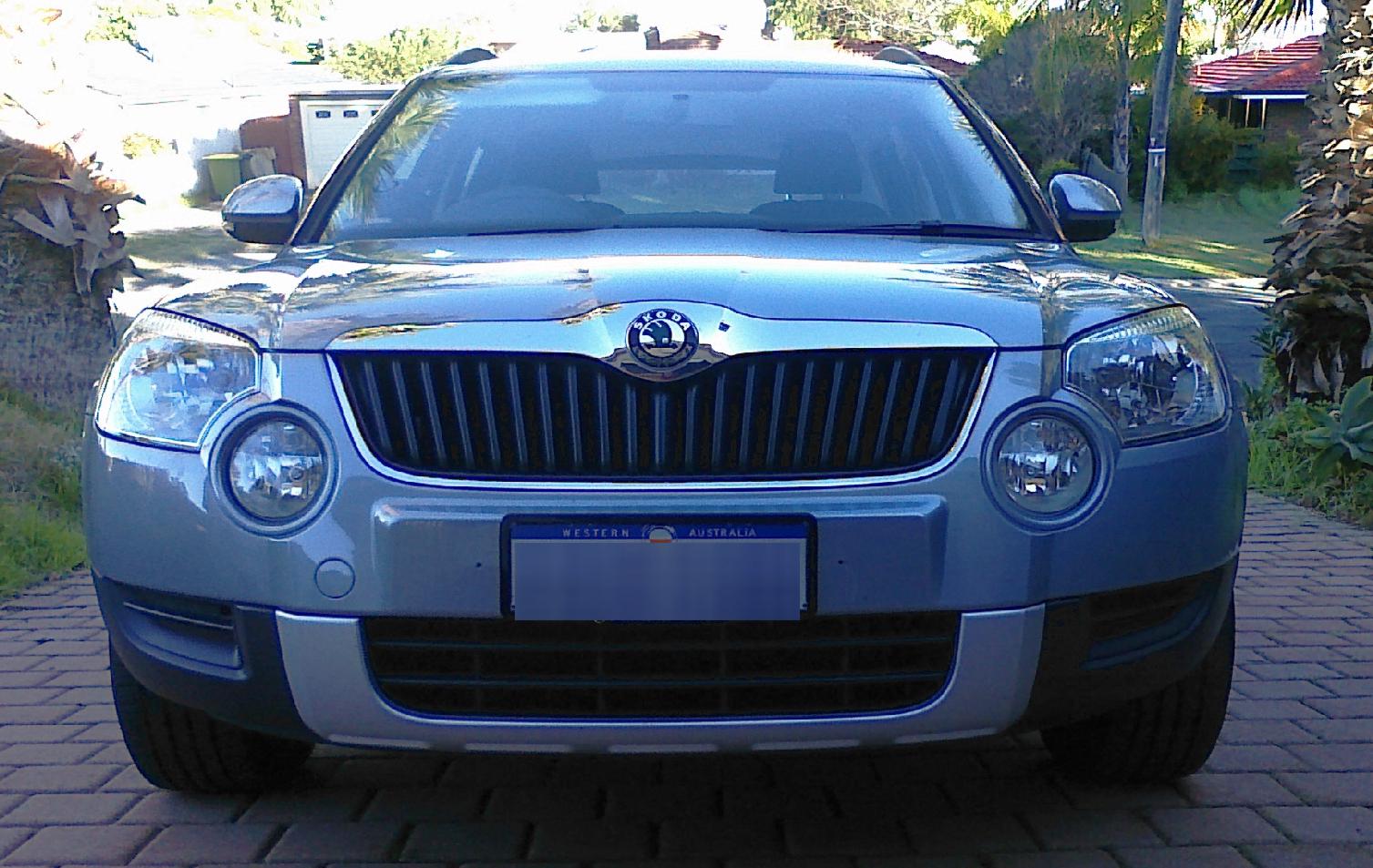Bohemian Snowman
2011 Škoda Yeti 1.2TSI FWD DSG
Driven 2013-05-30 to 2013-06-30 by Bernd Felsche
Bernd Felsche spent some time at the helm of a Bohemian
VW cousin; a Škoda Yeti powered by the 1.2 litre TSI engine
driving only the front wheels via a DSG automatic transmission.
VW Genes
The collapse of the rusty iron curtain in 1989 brought the
industrial decay behind the curtain into sharp contrast to the
industries against which the liberated would have to compete.
Czechoslovakia was one of the many countries that had a lot of
catching up to do. Unlike the former East Germany, it didn't
have a rich cousin to pay to "immediately" replace all the old
machinery, roads, rail, etc.
The Pilsen-based Škoda engineering conglomerate, which had
acquired car maker Laurin & Klement in 1925, was split shortly
after World War 2, leaving the car manufacturing branch as
a separate entity. Škoda Auto based in Mladá
Boleslav was to make arguably some of the best cars produced
behind the iron curtain.
They were good enough to export to "the West" (even to
Australia) to earn hard currency, but quality was compromised by the
need to conform to the planned economy.
|
In 1990, VW spotted the opportunity to adopt the privatised
Škoda Automobile company, giving VW access to another
automotive heritage dating back a century, to the 1890's via
Laurin & Klement;
a favourable investment climate, a technically skilled
and ambitious workforce and a fresh market, hungry for modern cars.
By the end of the 1990's, a decade that included the amicable
dissolution of Czechoslovakia into the Czech and Slovak Republics,
VW had not only increased its shareholding of Škoda Auto,
it'd infused vast amounts of technical DNA into new models produced
by Škoda, in models developed from times under communism, but
also fresh ones developed in the basis of VW platforms.
|

|
Family Matters
Škoda vehicles imported into Australia are carefully chosen
to complement the offerings of other group brands imported to
Australia.
It's a different story in e.g. Europe where Škoda faces off
against VW and Audi, putting up a good fight and not infrequently,
persuading buyers to opt for the Czech marque.
In Australia the also Yeti provides many of the same features as the
VW Tiguan in a package of the same size but engine, drivetrain and
trim options differentiate the two.
As does price.
Škoda Auto honour the Laurin & Klement heritage by
assigning it to the luxury trim level of most of their models in
Europe.
Which doesn't exactly endear them to Audi, as Audi is supposed to be
the everyman-luxury brand within the VW group.
If you think that Audi are over-reacting, take a drive in a
Škoda Superb wagon and compare it to an Audi of equivalent
quality, size and features.
Yeti Another Funny Name
Don't laugh. Look at the sales.
The Yeti is one of Škoda's best-selling cars since first going
on sale in 2009.
Its popularity and competence are underscored by winning Top Gear's
Family Car award that year.
One of many awards.
Two Useful Boxes
The whole car, from the simple two-box shape standing high with a
wheel at each corner, reeks of practicality; but not to the
detriment of comfort.
Škoda's styling department has managed to avoid ugliness by a
long distance.
A lot of people like the look.
One becomes accustomed to what look like tiny wheels (they're
16-inch wheels!) in the huge wheel arches that seem to leave enough
space to accommodate chickens.
The swooping B-pillar effect on the front doors gives the Yeti an
instantly recognizable shape in the shopping centre carpark; amongst
the many other faux-wheel-drives.

The shape of the car is quite deceptive. It's smaller than it looks
and it doesn't take up more garage floor space than a Golf.
And the Golf is appropriate to mention here because the Yeti borrows
not only mechanical components from the VW goodies box, but also
some of the interior trim.
Which is certainly not to the detriment of the Yeti.
The vertical rear hatch is wide, providing good access to the
interior.
A number of hooks are provided, along with a net, to stop your
precious cargo going its own way around the capacious and variable
compartment.
Rear seats are individually foldable, moveable and removable,
allowing the owner to adapt the vehicle's capacity to best suit
their individual needs.
Due to the strength needed in modern car seats to satisfy
crashworthiness requirements, the seats are however heavy; so you'll
not want to lift them out and in too often — except perhaps to
save on gymn costs.
Thanks to the upright sitting position in both the front and the back
seats, there's room for adults in every seat.
Removing the centre seat in the back row allows the outer seats to
be slid towards the centre, providing plenty of elbow-room in the
back.
That is however at the expense of the tray integrated into the back
of the centre seat.
Getting in and out of the car is a doddle thanks to the height of
the car and the wide-opening doors.
That's appreciated especially by those whose joints and bones aren't
as flexible as they might wish.
Silent Snowman
The doors close solidly with the trademarked VW thunk and you
will be hard-pressed to hear the engine at idle.
Which is not just due to the engine itself but also the excellent
isolation, insulation and sound-absorbing surfaces in the car's
interior.
Once moving, the light, yet positive steering impresses with
accuracy, blemished by a total lack of feedback from the wheels on
the ground; now seemingly par for the course for the
electro-mechanically assisted steering setups in VW group vehicles.
Brake and accelerator pedals are also light to operate.
Brakes work well even with the light pedal.
The car stops well. Anti-lock brakes mean that the car can still be
steered while slowing the car as quickly as possible, even on
tricky surfaces.
The accelerator is a good drive-by-wire job, the engine throttle
responds quickly but the action of the automatic gear change
sometimes frustrates being able to do exactly what one wants with
the car.
A pregnant pause, seemingly euivalent to an elephant's gestation
period, can leave the car breathless" at suburban speeds when
a burst of acceleration is needed for e.g. a safe lane change on a
busy road.
Multiple Personality Order
The DSG transmission can be operated in 3 modes.
Standard Drive performs adequately in light traffic, changing
to the highest available gear for the road speed.
That works OK for economy; on average.
Sports mode is quite aggressive, especially in the way that
it holds onto lower gears, even at moderate speeds.
It does the right thing as one backs off on the accelerator quickly
approaching corners or sharp bends by changing down a couple of cogs
to keep the engine in its broad power band.
Hanging onto a lower gear to keep the engine on-tap is probably to
the detriment of fuel economy when cruising.
Fortunately, one doesn't have to stop the car to change the
personality of automatic gear changes; just push the lever to
D when cruising.
Manual, sequential gear selection is also available by moving
the selector lever to the left.
A push back changes down one gear and a push forward changes up.
Although the changes aren't instantaneous, they're at least as fast
as a change with a manual gearbox with one difference; you don't
have to take your foot off the throttle when changing up or down.
The brains of the DSG prevents sequential changes that are
impossible or which would damage the engine or the gearbox.
Such changes are simply delayed until they are possible.
First gear of the seven is very low, perhaps in deference to the
off-road looks.
Locked into first or even in sports mode, dropping the lead foot can
produce not only breaking of traction, but axle tramp of sorts.
The driver has to be sufficiently coherent to lift the foot because
the car isn't going to make it look elegant from any perspective.
Behind the Chrome Mo'
The engine is in the front, just in front of the axle.
It's mounted sensibly high for an "off-road" car.
There is plenty of space in the engine compartment, certainly enough
to house the much bigger 2.0-litre TDI of the 4WD version.
Škoda is said to have driven the development of the 1.2 TSI,
using the 16-valve 1.4 TSI as a base.
Development shed about 24 kg; by simplification and other means,
bringing the engine mass down to about 89 kg.
The result is used in a number of small to medium cars produced by
the VW group.
1.2 litres doesn't sound like a big engine, but this one is
direct-injected and turbocharged.
An alloy block is used with cast iron cylinder liners and a
chain-driven overhead camshaft.
The 8-valve cross-flow head has an air-liquid "intercooler"
mounted at the back to cool the intake air after it's compressed by
the turbocharger at the front of the engine.
Thanks largely to the small, variable geometry turbocharger, the
engine develops maximum torque of 175 Nm from about 1500 rpm to
beyond 4000 rpm.
Maximum power is 77 kW, produced at 5000 rpm.

|
The engine draws fresh air from above the radiator, behind the
chrome moustache above the vertically-slatted, black grille.
It's a little engine but the power characteristic is more like that
of a big four.
Which is not bad news as the low engine speeds not only mean
potentially better combustion and therefore better use of fuel, but
also a longer life because the pistons don't have to move as far per
kilometre driven.
The small engine warms up quickly, but it also cools down more
quickly than the bigger-block engines.
You'll notice that in winter.
|
The View from On High
Visibility all around the car is excellent.
Combined with the boxy shape, this makes the Yeti easy to place on
the road and in a parking spot.
The view inside is made imperfect by two problems evident
from the author's favoured driving position; the speedometer and the
view of the road through the windscreen.
With the seat positioned to give a high driving position, the author
found that the numbers on the left side of the speedometer scale
were unreadable — no numbers from 20 to 80 km/h —
because the speedometer's bezel is not angled towards the
driver.
From the same driving position, the rear view mirror on the windscreen
often obscures part of the view of the road across the corner when
turning left.
It can also create a blind spot for a car on an on-ramp to the
freeway.
The mirror seems to be a too low on the windscreen; about 20
centimetres from the top; almost in the centre of the screen.
Flipping down the sun visor on the driver's side can be a pain as
the recess in the (plush) headliner that allows for a proper grip on
the visor, is well to the left of the visor.
Drivers with long fingernails may have problems.
Singin' the Blues
Steering wheel controls for the onboard trip computer also let the
owner set certain comfort options and to manage daytime running
lights.
Buttons are also used to pair the Škoda's audio
system with most Bluetooth-capable mobile phones, with the dashboard
display used to access the phone's contact list (when available) to
make calls.
Calls can be answered by pressing a button on the steering wheel,
which silences the usual audio programme, be it radio or CD.
The author wondered why he couldn't play the music stored on his
mobile phone, using the Bluetooth connection.
The Swing audio system can play CDs loaded with MP3 tracks
providing many hours of Mahler,
Wagner, Beethoven and Verdi to keep the kids
entertained on a long drive, all from the one disc.
There's an auxiliary audio input socket in the centre console,
providing basic connectivity for other player devices;
not the ability to e.g. skip tracks, but at least
the volume can controlled.
Picky Drinker
In a VW with central locking, one traditionally finds that the fuel
filler flap is locked along with all the doors.
Škoda might have a historically-based aversion to centralised
control, so the filler flap opens to reveal an ordinary, key-locking
filler cap to protect the precious fluid from nefarious types.
Refuelling shouldn't happen too often.
The little TSI goes about 600 km on a tankfull, depending on how you
drive and the quality of the fuel, you might exceed 700 km.
But not likely with lots of suburban driving.
Although the engine will run on premium unleaded petrol (PULP) with
95 octane rating, it works better on 98 RON,
providing a sharper response and lower fuel consumption.
People will have to work it out for themselves which fuel works best
for their life.
Europeans have the option of a Yeti Greenline with
1.6-litre TDI engine, driving the front wheels through a 5-speed
manual transmission.
That uses quite a bit less fuel; expect more than 1000 km when
cruising; but isn't available with a DSG transmission;
perhaps to help save the planet.
Australian may rejoice that they can also buy a diesel Yeti, the
2.0-litre TDI developing 103kW and gobs of torque, with either
manual and DSG 6-speed transmission, driving all 4 wheels.
Even that model's fuel consumption is lower than the TSI's.
But there are still good reasons for people to buy a petrol engined
car than a diesel; one of them being the price difference (in this
case, unfair to compare because of the power and drivetrain
differences) and that the fuel savings for a few short trips simply
don't add up.
Besides; when it's cold, you appreciate that the petrol engine is
less efficient because the inefficiency means more heat for the
car's interior.
Making Tracks
On the road, the Yeti is generally quiet, the engine remains
audible but subdued while cruising.
Road noise often exceeds engine noise, especially on WA's rough
high-friction highway surfaces.
Ride is smooth.
The suspension, while supple, keeps body roll to a
minimum while cornering.
This particular Yeti is only front-wheel drive making it little more
suitable for off-road use than any other front-wheel drive car.
Ground clearance and short overhangs will help when negotiating
rougher tracks and getting over those pesky kerbs.
Even the four-wheel drive Yeti probably shouldn't be considered a
serious off-roader.
Slowly reversing the Yeti diagonally down a mountable kerb reveals
movement at the door rubbers, so the large body shell probably
doesn't have the structural rigidity for heavy duty off-roading.
Nevertheless, the Internet abounds with videos of people
successfully negotiating dirt, sand and mud tracks in 4WD Yetis.
Wrapper
The Škoda Yeti with 1.2 TSI engine driving the front wheels
works well as a large "hatchback wagon", providing space for adults
in all seats as well as a sizeable luggage compartment.
Although the engine is small in displacement, the turbocharger adds
more than sufficient motivation to the car, letting it easily keep
up with traffic.
On the road, the car is generally quiet and rides comfortably,
though road noise can be intrusive on some rough surfaces.
Handling is top class; surprisingly good for such a tall vehicle.
With current pricing (mid-2013), the Yeti discount packages offer
excellent value, competitive with brands from Asia.
Copyright © 2013 Bernd Felsche, Perth, Western Australia
All Rights Reserved


